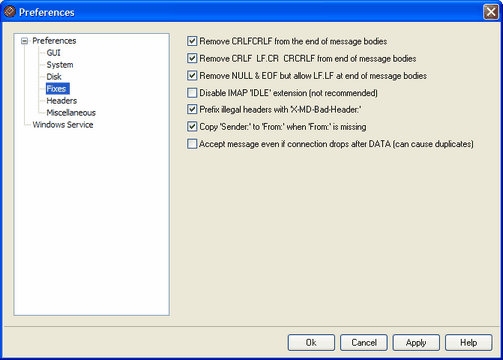
Remove CRLFCRLF from the end of message bodies
Certain mail clients have problems displaying messages that end with consecutive Carriage Return Line Feeds (i.e. CRLFCRLF). When this box is checked, MDaemon will strip consecutive CRLFCRLF sequences from the end of the message body. This option is enabled by default.
Remove CRLF LF.CR CRCRLF from the end of message bodies
By default, MDaemon will remove this sequence from the end of messages, as it can cause problems for some mail clients. Uncheck this box if you do not wish to remove this sequence from messages.
Remove NULL & EOF but allow LF.LF at the end of message bodies
When this box is checked MDaemon will remove Null and EOF characters from the end of message bodies, but it will allow messages ending in LF.LF, as well as messages ending with the normal CRLF.CRLF sequence that signifies the end of a message. This option is enabled by default.
Disable IMAP 'IDLE' extension (not recommended)
A few older mail clients have problems with the IMAP IDLE extension. Disabling MDaemon's support for this extension is not recommended, but it is possible through this option. If you notice that your users are experiencing problems then you can check this box to disable IMAP IDLE support.
Prefix illegal headers with "X-MD-Bad-Header:"
When this option is enabled and MDaemon encounters a bad message header, it will prefix the bad header with "X-MD-Bad-Header:" This option is enabled by default.
Copy 'Sender:' to 'From:' when 'From:' is missing
Some mail clients fail to create a FROM: header when you compose a message. Instead, the FROM: header's information is placed in the Sender: header. This can cause problems for some mail servers as well as the recipient of your message. To help prevent these problems, MDaemon will create the missing FROM: header by using the contents of the Sender: header when this box is checked. This option is enabled by default.
Accept message even if connection drops after DATA (can cause duplicates)
When this option is enabled, MDaemon will accept and deliver a message even if there's a connection abort during or immediately after the DATA command during the SMTP process. This should not be used under normal circumstances as it can lead to duplicate messages.